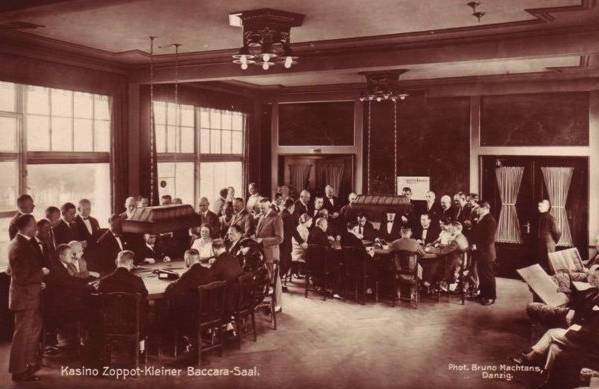
Produced: State porcelain - Manufactory Meissen

Online collections
monedastodas.com
All collections » Notgeld coins » Porcelain notgelds » Zoppot

Produced: State porcelain - Manufactory Meissen
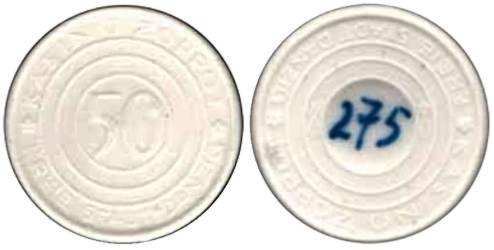
Photo: Auction Berlin TM120/2008/850 EUR
50 without denomination (Gulden) (1931)
40,0 white porcelain
pattern from a plaster stamp.
Obverse: central number 50, inner ring empty, middle ring empty, outer ring
inscription: (rosette) KASINO ZOPPOT (rosette) FREI STADT DANZIG
Reverse turned on 180 degrees, number 275 in the middle, inner ring has 2 pairs
of Meissen swords engraved, middle ring is empty, outer ring inscription:
(rosette) KASINO ZOPPOT (rosette) FREI STADT DANZIG
Rosettes without a point in the center
Scheuch -
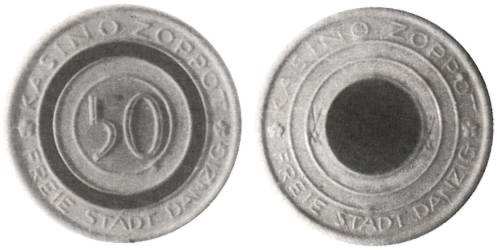
Photo: Money Trend 12/95
50 without denomination (Gulden) (1931)
40,0 white porcelain
pattern from a plaster stamp.
Obverse: central number 50, inner ring empty, central ring blue glaze, outer
ring inscription: (rosette) KASINO ZOPPOT (rosette) FREI STADT DANZIG
Reverse turned on 180 degrees, blue glaze in the middle, inner ring has 2 pairs
of Meissen swords engraved, middle ring empty, outer ring inscription: (rosette)
KASINO ZOPPOT (rosette) FREI STADT DANZIG
Rosettes without a point in the center. rim - blue line
Scheuch -
50 without denomination (Gulden) (1931)
40,0 white porcelain
pattern from a plaster stamp.
Obverse: central number 50, inner ring - convex, 2 pairs of Meissen swords,
middle ring empty, outer ring inscription: (rosette) KASINO ZOPPOT (rosette)
FREI STADT DANZIG
Reverse - blue glaze inside, outer ring inscription: (rosette) KASINO ZOPPOT
(rosette) FREI STADT DANZIG
Rosettes without a point in the center. rim - blue line
Scheuch -
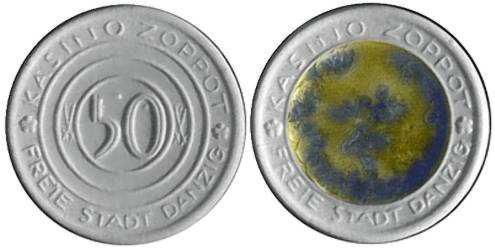
Photo41 Auction Berlin Tempehofer Muenzenhaus 1987
50 without denomination (Gulden) (1931)
40,0 white porcelain
pattern from a plaster stamp.
Obverse: central number 50, inner ring - convex, 2 pairs of Meissen swords,
middle ring empty, outer ring inscription: (rosette) KASINO ZOPPOT (rosette)
FREI STADT DANZIG
Reverse - yellow-blue glaze inside, (yellow-green according to MT) outer ring
inscription: (rosette) KASINO ZOPPOT (rosette) FREI STADT DANZIG
Rosettes without a point in the center. rim - green rim
Scheuch -
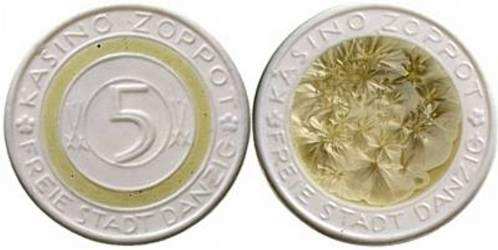
Photo: EMPORIUM Hamburg Auction69/2013/1050 EURO)
5 without denomination (Gulden) (1931)
40,0 white porcelain
pattern from a plaster stamp.
Obverse: central number 5, inner ring - convex 2 pairs of Meissen swords, yellow
middle ring, outer ring inscription: (rosette) KASINO ZOPPOT (rosette) FREI
STADT DANZIG
Reverse - yellow glaze inside, outer ring inscription: (rosette) KASINO ZOPPOT
(rosette) FREI STADT DANZIG
Rosettes without separate petals. rim - yellow rim
Scheuch -
5 without denomination (Gulden) (1931)
40,0 white porcelain
pattern from a plaster stamp.
Obverse: central number 5, inner ring - convex 2 pairs of Meissen swords, yellow
middle ring, outer ring inscription: (rosette) KASINO ZOPPOT (rosette) FREI
STADT DANZIG
Reverse - yellow-blue glaze inside, outer ring inscription: (rosette) KASINO
ZOPPOT (rosette) FREI STADT DANZIG
Rosettes without separate petals. rim - yellow rim
Scheuch -
5 without denomination (Gulden) (1931)
40,0 white porcelain
pattern from a plaster stamp.
Obverse: central number 5, inner ring - convex 2 pairs of Meissen swords,
yellow-green middle ring, outer ring inscription: (rosette) KASINO ZOPPOT
(rosette) FREI STADT DANZIG
Reverse - yellow-green glaze inside, outer ring inscription: (rosette) KASINO
ZOPPOT (rosette) FREI STADT DANZIG
Rosettes without separate petals. rim - yellow-green rim
Scheuch -
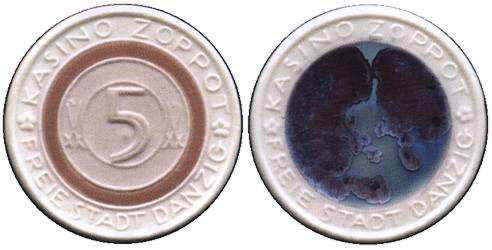
Photo141/2013 Auction Berlin Tempehofer Muenzenhaus - 950 EUR
5 without denomination (Guldenów) (1931)
40,0 white porcelain
pattern from a plaster stamp.
Obverse: center number 5, inner ring - convex 2 pairs of Meissen swords, center
ring purple red, outer ring inscription: (rosette) KASINO ZOPPOT (rosette) FREI
STADT DANZIG
Reverse - blue glaze inside, outer ring inscription: (rosette) KASINO ZOPPOT
(rosette) FREI STADT DANZIG
Rosettes without separate petals. rim - purple red rim
Scheuch -
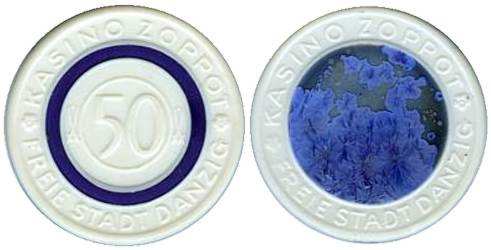
PhotoArtur Szewczyk
50 without denomination (Gulden) (1931)
40,0 white porcelain
Made of steel stamp.
Obverse: central number 50, inner ring - convex, 2 pairs of Meissen swords, blue
middle ring, outer ring inscription: (rosette) KASINO ZOPPOT (rosette) FREI
STADT DANZIG
Reverse - blue glaze inside, outer ring inscription: (rosette) KASINO ZOPPOT
(rosette) FREI STADT DANZIG
Refined rosettes. rim - blue rim
Scheuch - 314w
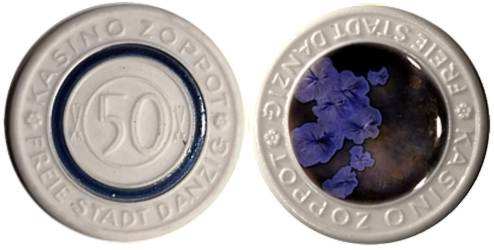
maShops/2014/269EUR
50 without denomination (Gulden) (1931)
40,0 white porcelain
As above, variety obverse reversed by 180 degrees
Scheuch - 314w
50 without denomination (Gulden) (1931)
40,0 white porcelain
Made of steel stamp.
Obverse: central number 50, inner ring - convex, 2 pairs of Meissen swords,
yellow middle ring, outer ring inscription: (rosette) KASINO ZOPPOT (rosette)
FREI STADT DANZIG
Reverse - yellow glaze inside, outer ring inscription: (rosette) KASINO ZOPPOT
(rosette) FREI STADT DANZIG
Refined rosettes. rim - yellow rim
Scheuch - 314x
50 without denomination (Gulden) (1931)
40,0 white porcelain
Made of steel stamp.
Obverse: central number 50, inner ring - convex 2 pairs of Meissen swords,
red middle ring, outer ring inscription: (rosette) KASINO ZOPPOT (rosette)
FREI STADT DANZIG
Reverse - red glaze inside, outer ring inscription: (rosette) KASINO ZOPPOT
(rosette) FREI STADT DANZIG
Refined rosettes. rim - red otok
Scheuch - 314y
50 without denomination (Gulden) (1931)
40,0 white porcelain
Made of steel stamp.
Obverse: central number 50, inner ring - convex, 2 pairs of Meissen swords,
middle ring empty, outer ring inscription: (rosette) KASINO ZOPPOT (rosette)
FREI STADT DANZIG
Reverse - yellow glaze inside, outer ring inscription: (rosette) KASINO ZOPPOT
(rosette) FREI STADT DANZIG
Refined rosettes. rim - without rimline
Scheuch -
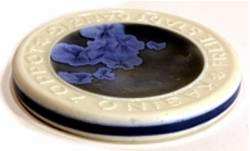
Photo of the ring line
The photo below shows tokens of Sopot with a museum in a factory in Meissen:
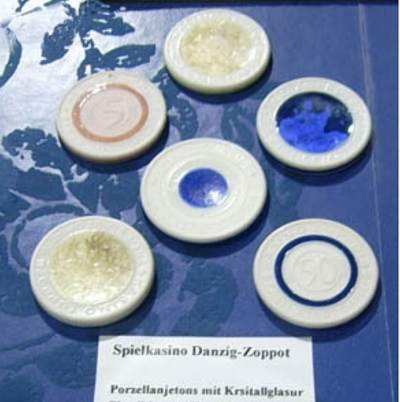
porcelain-Museum Meissen